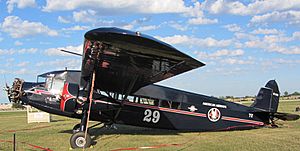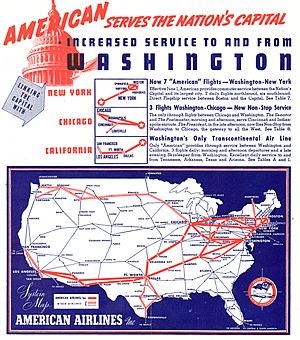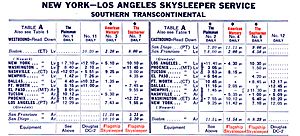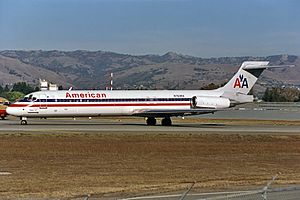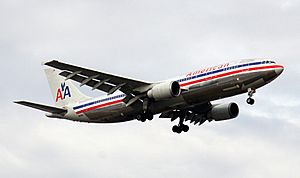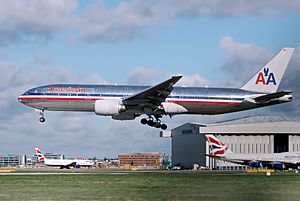History of American Airlines facts for kids
American Airlines is a major airline in the United States, known for its long history and many changes. It started in 1930 from a group of 82 smaller airlines and has grown a lot since then, merging with other airlines like Trans World Airlines (TWA) and US Airways.
Contents
How it All Began
American Airlines began in 1930 when many small airlines joined together. At first, "American Airways" was a common name used by several independent companies. These included airlines in Texas, the western U.S., the Midwest, and the Northeast. Like many early airlines, American earned money by carrying U.S. Mail. By 1933, American Airways had routes connecting 72 cities, mainly in the northeastern, midwestern, and southwestern parts of the country.
In 1934, a businessman named E. L. Cord bought American Airways and changed its name to "American Air Lines." He hired C. R. Smith to manage the company. Smith worked with Donald Douglas to create the Douglas DC-3 airplane. American Airlines was the first to fly the DC-3 in 1936. This plane was special because it was the first aircraft that could make a profit just by carrying passengers, without needing to carry U.S. Mail.
With the DC-3, American Airlines started calling its planes "Flagships." They also created the Admirals Club for their important passengers. The DC-3 planes even had a small "admiral's pennant" flag outside the cockpit window when they were parked. American began offering daily overnight flights across the country, from New York to Los Angeles, with stops in places like Dallas/Fort Worth. They called this their "all-year southern route."
American Airlines was also the first to work with Fiorello LaGuardia to build an airport in New York City. At the new LaGuardia Airport, American opened the world's first airline lounge, which was also called the Admirals Club. At first, you could only join if you were invited, but later, anyone could become a member by paying a fee.
For many years, American Airlines' most famous service was its daily flights between New York and Los Angeles. These flights were called #1 (westbound) and #2 (eastbound). In 1939, a flight from New York to Los Angeles took over 20 hours and made eight stops! Passengers even had to change planes in Memphis. Today, a non-stop flight between New York (JFK) and Los Angeles (LAX) takes about six hours. Sadly, on March 1, 1962, Flight #1 crashed shortly after takeoff, and everyone on board was lost. However, American Airlines decided to keep #1 as the flight number, which is unusual after a fatal accident.
After World War II
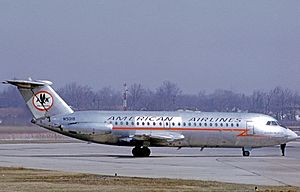
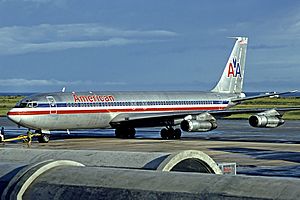
After World War II, American Airlines bought American Export Airlines and renamed it American Overseas Airways to fly to Europe. This part of the company was later sold to Pan Am in 1950. American also started a branch called American Airlines de Mexico S.A. to fly to Mexico and even helped build some airports there.
American Airlines was a very large airline. It was the biggest American airline until 1961, and the second largest in the world after Aeroflot.
American Airlines was interested in buying British-built de Havilland Comet jets, but they canceled their orders when problems were found with the Comet planes. On January 25, 1959, American Airlines started using Boeing 707 jets for transcontinental flights. They invested a lot of money in jet aircraft. American also launched the first electronic booking system, called Sabre, with IBM. They also built their own terminal at Idlewild Airport (now JFK) in New York City, which became their biggest base.
In 1967, Vignelli Associates designed the famous American Airlines eagle logo, which was used until 2013.
In the late 1960s, American Airlines asked plane manufacturers to design a wide-body aircraft that was smaller than the Boeing 747 but could still fly long distances from airports with shorter runways. McDonnell Douglas responded with the McDonnell Douglas DC-10 trijet. American Airlines ordered 25 DC-10s. The DC-10 first flew on August 29, 1970, and American's DC-10 made the first commercial flight of its type on August 5, 1971, between Los Angeles and Chicago.
In 1970, American Airlines had flights to Honolulu, Sydney, and Auckland. In 1971, American bought Trans Caribbean Airways. On March 30, 1973, American made history by hiring the first female pilot for a major airline, Bonnie Tiburzi, who flew Boeing 727s. American Airlines has also been a leader in the airline industry, introducing things like computer reservation systems and frequent flyer programs.
American Airlines also had a cargo service called American Freighter until 1984. They used special cargo-only Boeing 707 and Boeing 747 planes that had previously carried passengers.
The 1980s and 1990s
In 1979, American Airlines moved its main office from New York City to Fort Worth, Texas. In 1981, they started using a "hub-and-spoke" system, which means flights go to a central airport (the hub) and then connect to other destinations (the spokes). Their first hub was at Dallas/Fort Worth International Airport. In 1982, they opened another hub at Chicago O'Hare and began flying across the Atlantic Ocean between Dallas and London. Under their new leader, Robert Crandall, American expanded its services throughout the 1980s, adding flights to more places in Europe and also to Japan.
In the late 1980s, American Airlines opened three more hubs for flights going north and south: San Jose International Airport, Raleigh-Durham International Airport, and Nashville International Airport. However, these new hubs were later closed in the 1990s because they were not making enough money.
In 1991, American Airlines bought TWA's operations at London Heathrow Airport. For many years, American Airlines and United Airlines were the only U.S. airlines allowed to fly to Heathrow.
The 1990s were a good time for airlines, with lower fuel prices and more profits. However, on February 17, 1997, American Airlines pilots went on strike for higher wages. President Bill Clinton stopped the strike because it was hurting the country's economy. The pilots eventually agreed to a deal with lower wages than they had asked for.
Robert Crandall, the CEO of American, warned people about investing in airlines. He said that since airlines were allowed to operate more freely in the 1970s, many airlines had gone out of business. He believed airlines were a great place to work, but not a good investment.
Miami International Airport became a hub for American Airlines in 1990 after they bought routes to Central and South America from Eastern Air Lines. Throughout the 1990s, American Airlines became the main U.S. airline flying to Latin America.
On October 15, 1998, American Airlines was the first airline to offer electronic tickets in all 44 countries it served. In 1999, American Airlines, British Airways, Cathay Pacific, Canadian Airlines, and Qantas started a worldwide airline group called Oneworld.
The 2000s
Robert Crandall left American Airlines in 1998, and Donald J. Carty took over. In April 2001, Carty arranged to buy the struggling Trans World Airlines (TWA) and its hub in St. Louis.
American Airlines started losing money after the September 11 attacks in 2001, which destroyed two of its planes. Carty tried to make deals with the unions to cut wages and benefits, but he resigned when union leaders found out he was planning to give large bonuses to company leaders at the same time. This made it hard for the airline to build trust with its employees. Gerard Arpey became the new CEO. The St. Louis hub was made smaller, and the airline made other changes to save money. However, American also started flying to new places like Ireland, India, and China. In the second quarter of 2005, American made a profit for the first time in a long while.
American Airlines was a big supporter of the Wright Amendment, a law that limited flights at Dallas Love Field in Dallas. In 2006, American agreed with Southwest Airlines and the cities of Dallas and Fort Worth to try and get rid of the Wright Amendment, as long as Love Field remained a domestic airport with limited gates.
The 2008 financial crisis also put a lot of pressure on American Airlines. In July 2008, American had to lay off 950 flight attendants and store 20 MD-80 planes. They also reduced flights at their hub in San Juan, Puerto Rico. All their Airbus A300 jets were retired by August 2009.

American also closed its plane repair base in Kansas City, which it had gotten from TWA. In 2009, American announced it would close the Kansas City base in September 2010, leading to the loss of many jobs.
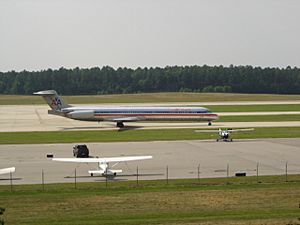
American Airlines had some problems with the FAA (Federal Aviation Administration) regarding the maintenance of its McDonnell Douglas MD-80 planes. In April 2008, they had to cancel 1,000 flights over three days to inspect wires. In 2009, there were reports that American was accused of hiding maintenance problems on some MD-80s, including issues with emergency slides and cracks. American started replacing its older MD-80 jets with newer Boeing 737s and Airbus A319s and A321s.
American was also important in helping Japan Airlines (JAL) in 2009–2011. American Airlines and Delta Air Lines were both interested in investing in JAL, which was having financial problems. In February 2010, JAL decided to strengthen its partnership with American Airlines and the Oneworld alliance. This led to a closer partnership between American and JAL starting in 2011.
The 2010s

In July 2010, American Airlines considered selling its regional airline, American Eagle. This was similar to what Delta Air Lines had done with its regional airlines.
In October 2010, American started a joint venture with British Airways and Iberia Airlines. This allowed them to work together more closely, including sharing frequent flyer benefits. The U.S. government approved this partnership.
American also began working with JetBlue Airways in March 2010. This partnership allowed travelers to connect to more destinations and earn frequent flyer miles on either airline.
American expanded its flights to Asia and the Pacific. They started flights to Tokyo's Haneda Airport from New York JFK. They also added flights between Los Angeles and Shanghai in 2011, and between Dallas/Fort Worth and Seoul in 2013. In 2014, they added flights from Dallas/Fort Worth to Shanghai and Hong Kong, offering the first non-stop flights between Dallas/Fort Worth and China. American also started daily flights from Los Angeles to Tokyo-Haneda in 2016, using their Boeing 787 Dreamliner planes. They also added daily flights from Los Angeles to Sydney, Auckland, and Hong Kong, returning to Australia and New Zealand for the first time in many years.
In late 2010, American Airlines had a disagreement with online travel agencies Expedia and Orbitz. American wanted to use its "Direct Connect" system for booking fares, which Expedia said might raise costs for passengers. Because of this, American removed its prices from Orbitz, and Expedia removed American Airlines' fares from its website.
In July 2011, American placed the "largest aircraft order in history," buying 460 new Boeing 737 and Airbus A320 planes. These planes were meant to replace older aircraft and help American have a more modern fleet. American Airlines was the second U.S. airline to receive the new Boeing 787 Dreamliner in January 2015.
American Airlines' Bankruptcy

AMR Corporation, which was the parent company of American Airlines, filed for Chapter 11 bankruptcy protection on November 29, 2011. This meant the company needed to reorganize its finances. As a result, American started reducing flights in July 2012, partly because some planes were grounded and there weren't enough pilots. American also stopped its service to Delhi, India, in March 2012.
By summer 2012, American was thinking about merging with another airline as part of its plan to get out of bankruptcy. They were considering merging with airlines like US Airways, JetBlue, and Alaska Airlines. On August 31, 2012, American Airlines and US Airways signed an agreement to discuss a possible merger.
American told over 11,000 workers that they might lose their jobs as part of the bankruptcy plan, and they cut flights by a small amount in September and October 2012. However, in October 2012, the airline announced plans to hire 2,500 pilots over two years for new routes.
On January 17, 2013, American introduced a new logo, paint design (livery), and brand image. They showed off the new look on their first Boeing 777 plane.
In October 2015, American announced a new "no-frills fare" to compete with low-cost airlines like JetBlue and Spirit Airlines. These new fares became available in 2016.
Merger with US Airways
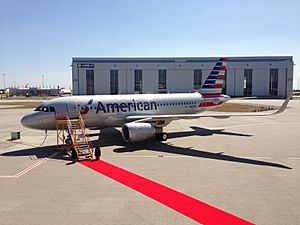
On February 14, 2013, AMR Corporation and US Airways Group officially announced that they would merge to create the largest airline in the world. The new company would be called American Airlines and use its branding, but US Airways' management team, led by CEO Doug Parker, would run most of the operations. The main office would be in Fort Worth, Texas. This merger would create a huge airline that, along with United Airlines and Delta Air Lines, would control a large part of the U.S. airline market.
The U.S. Department of Justice and several states tried to block the merger in August 2013, saying it would lead to less competition and higher prices. However, on November 12, the airlines reached an agreement with the Justice Department. As part of the deal, the new American Airlines had to give up some flight slots and gates at airports like Washington Reagan National and LaGuardia to other airlines. They also agreed to keep their operations at certain levels at their main hubs for three years. AMR and US Airways Group completed the merger on December 9, 2013, creating the new company American Airlines Group.
On April 8, 2015, the Federal Aviation Administration gave American Airlines and US Airways a single operating certificate, meaning they were officially one airline. The US Airways brand was stopped on October 17, 2015, and all flights became "American Airlines." The repainting of US Airways planes to the American Airlines colors was finished in 2017.
Recent Changes and COVID-19
Since 2018, American Airlines has made big changes to its international flights. They cut some routes to Asia and added more flights to Europe from their Chicago hub. They also tried new routes from their Philadelphia hub and expanded service to Haneda Airport in Tokyo.
In late 2018, American stopped flying from Chicago to Shanghai and Beijing because those routes were not making money. They also reduced flights from Chicago to Tokyo. However, they added new summer routes from Chicago to Venice and Athens, and planned new routes to Budapest, Prague, and Krakow in 2020.
American also added new flights from Philadelphia to places like Budapest, Prague, Berlin, Bologna, and Dubrovnik. In 2020, they announced service to Casablanca, Morocco, which was their first route to Africa. They also added new transatlantic flights from other hubs like Charlotte to Munich, and Dallas/Fort Worth to Dublin and Munich. American also resumed service to Israel, flying to Tel Aviv from Dallas/Fort Worth.
In spring 2020, American shifted all its Tokyo flights from Narita Airport to Haneda Airport for its Los Angeles hub, and one daily flight from Tokyo to Dallas/Fort Worth also moved to Haneda.
After merging with US Airways, American Airlines faced some challenges. While the merger went fairly smoothly, American was behind its rivals in some areas and had a lot of debt. In summer 2019, they had flight problems due to issues with the Boeing 737 MAX groundings, disagreements with workers, and bad weather.
In March 2020, maintenance workers approved a new union contract, which helped bring all of American's workers under the same agreements after the merger.
In May 2020, American announced it would cut 30% of its management staff because of falling revenues during the COVID-19 pandemic. In October 2020, the airline had to lay off 19,000 employees, but they were rehired when the government passed a new aid package. American Airlines also retired over 100 aircraft, including its E190, A330, 757, 767, and CRJ200 fleets. This means they now have the youngest fleet among the older, established airlines. In 2020, the company reported a record loss of $8.9 billion.
The 2020s
In February 2021, American announced that 13,000 workers would be laid off if government support was not extended again. However, after the American Rescue Plan Act of 2021 was passed, the layoffs were canceled.
On December 7, 2021, American Airlines Group announced that Doug Parker would retire as CEO on March 31, 2022. Robert Isom, who was the president of American, became the new CEO.
On February 28, 2022, because of the conflict between Russia and Ukraine, American Airlines stopped its agreements with Russian airlines Aeroflot and S7, including its Oneworld frequent flyer program with S7.
On June 9, 2022, American Airlines' official Twitter page said they were thinking about removing their ban on smoking during flights, which has been in place since the 1990s.
Former Hubs
- Nashville – American opened a hub here in 1986 but closed it in 1995 because it wasn't profitable.
- Raleigh/Durham – This hub opened in 1987 and closed in 1995 for similar reasons.
- San Jose (CA) – American closed its San Jose hub in the early 2000s. It had been started in 1988 after American bought Air Cal.
- San Juan – This hub opened in 1986 and closed in 2012. American used San Juan as a connection point for flights to Caribbean islands.
- St. Louis – American closed its St. Louis hub in 2009 because it was no longer needed as a second hub in the Midwest. This hub was inherited from Trans World Airlines.



